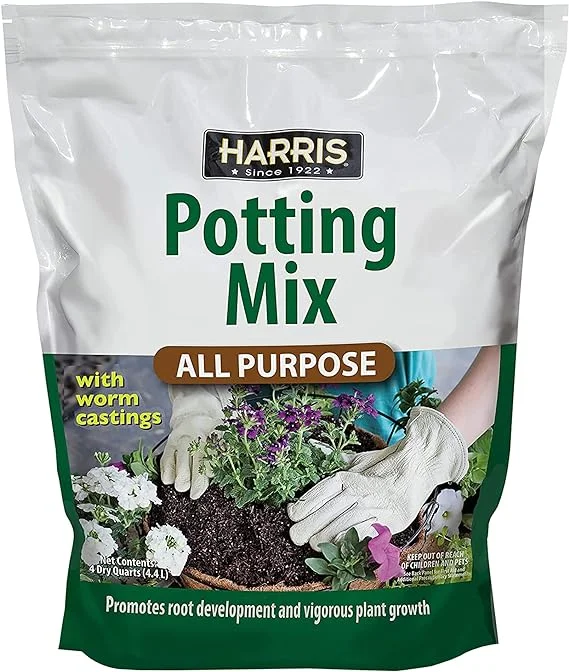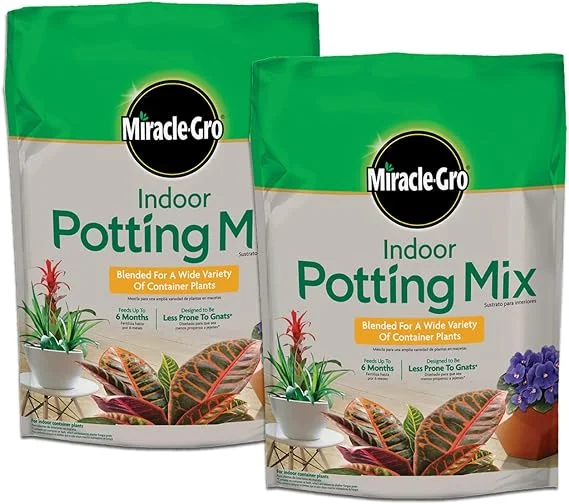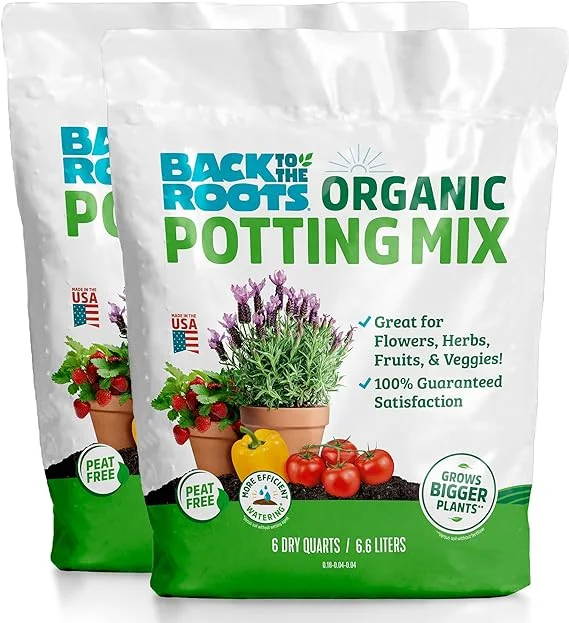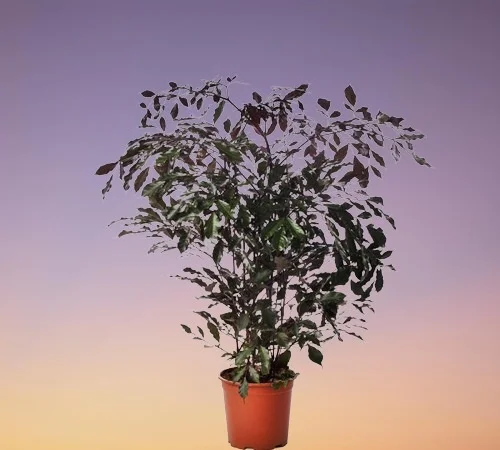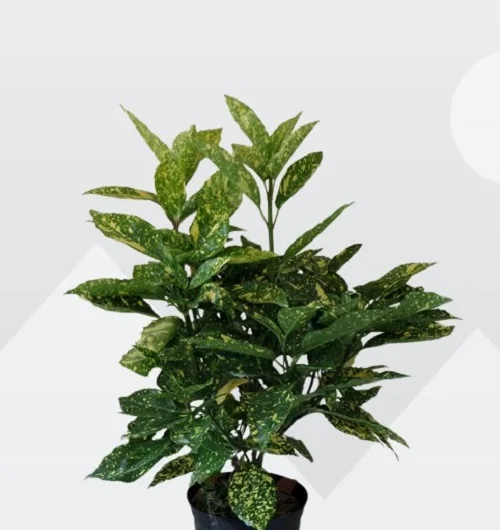Podocarpus macrophyllus (Buddhist Pine) Indoor Care, Common Problems and Solutions
Some links in this post may be affiliate links
Podocarpus macrophyllus (Buddhist Pine) blossoms in bright light with some direct sunlight, average warmth, moderate humidity and moderately moist, rich, well-drained, all purpose soil coupled with monthly feeding in the growing season.
Buddhist Pine also called Yew Plum Pine, Japanese Yew or Fern Pine is one of the popular tree-like plants and bears narrow, glossy, leathery, strap-shaped, dark-green leaves with a central midrib which are about 6-12 cm long and 1 cm wide.
Yew Plum Pine is a slow-growing plant with upright stems. It does not mind a drafts situation and requires little attention. These factors place it among the best plants for a front porch or entrance where it will create a great first impression.
Japanese Yew is a coniferous plant. The cones are borne on a short stem and have 2-4 scales, usually 1 or 2 fertile, each fertile scale bears a single apical seed 10-15mm.
Fern Pine is highly regarded as a feng shui tree in Hong Kong. The tree can also be trained as a bonsai.

Botanical name: Podocarpus macrophyllus
Family: Podocaroaceae
Common names: Buddhist Pine, Yew Plum Pine, Fern Pine, Japanese Yew
Origin
Podocarpus macrophyllus is native to southern Japan and southern and eastern China.
Size
In its natural habitat Yew Plum Pine can reach a height of 30-40 feet. Indoors it will reach a height of about 6 feet. Regular pruning will keep the plant as a compact shrub.
Is Buddhist Pine Toxic?
Buddhist Pine is toxic to both humans and pets as indicated by ASPCA. The fruits and the leaves contain a poisonous substance which causes severe drooling, vomiting, diarrhea and abdominal pains if ingested.
Where to Buy
If you are looking to acquire Buddhist Pine, they are available online on Etsy (Link to Etsy).
Caring for Podocarpus macrophyllus
With the right care, Podocarpus macrophyllus thrives indoors, making it a fantastic choice for indoor plant lovers. This guide covers everything you need to know about growing and maintaining Buddhist Pine indoors, from light requirements, watering, pruning, to potting.
Buddhist Pine (Podocarpus macrophyllus) flourishes in bright light with 4-6 hours of direct sunlight, average warmth of 15-240C, humidity of 50-55% and moderately moist, rich, well-drained, all purpose potting soil coupled with monthly feeding during the growing season.
Podocarpus macrophyllus care requires repotting only when it has become pot-bound. Regular pinching of the growing tips is needed to encourage a compact growth and control the height of the plant. Keep reading for more on these growing conditions and how to achieve them.
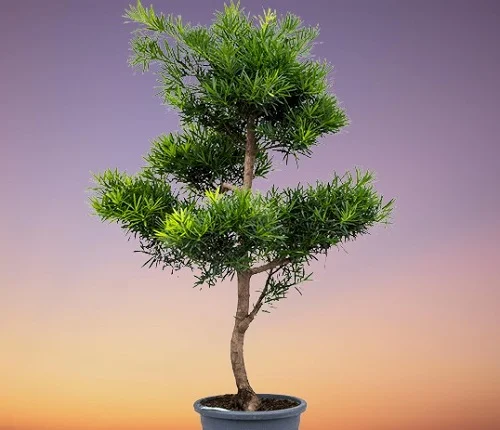
Light Requirements
Buddhist Pine requires bright light with 4-6 hours of direct sunlight; an east- or west-facing window where it can receive some direct sunlight is ideal.
Low light will result in elongated, sparsely spaced leaves which is an attempt by the plant to reach the light source. Therefore, you may grow the plant under a grow light if the natural light is inadequate.
Rotate the pot regularly to ensure that the plant receives light on all sides for uniform growth and prevent lopsided growth.
Watering
Water your Podocarpus macrophyllus thoroughly during the growing season when 1-2 inches dry out for the optimal growth of the plant. Keep the soil moderately moist but avoid overwatering as it can lead yellowing leaves.
Decrease watering for the Yew Plum Pine in the cold season as growth at this time is minimal. However, do not allow the soil to dry out completely which can result in brown leaf tips and leaf drop.
Ensure that the pot has a drainage hole to prevent the soil from getting soggy as it can result in yellowing and root-rot and eventual death of the plant if not corrected.
Potting Mix
Podocarpus macrophyllus soil should be rich in organic matter and free-draining to prevent it from getting soggy while providing the required nutrients. Most all purpose potting mixes are ideal for this plant.
Temperature and Humidity
Buddhist Pine prefers average temperatures of 15-240C. The plant does not mind cold drafts as it is a cool climate plant.
Podocarpus macrophyllus has no need for high humidity. Average humidity of 50-55% is ideal for this plant. However, if you note brown leaf tips and edges, the air is too dry. Therefore, to scale up humidity set the pot on a wet pebble tray or use a cool mist humidifier.
Occasionally wash the leaves with plenty of water to get rid of dust and discourage pest infestation. Ascertain that there is good ventilation to prevent fungal diseases.
Fertilizer
Feed your Podocarpus macrophyllus with a balanced, water-soluble fertilizer every 4 weeks during the growing period for a lush growth. Do not feed in the cold season as growth is minimal and feeding at this time can cause fertilizer burn and death of the plant.
Repotting
Repot Buddhist Pine during the growing season only when it has overgrown its current pot. The plant is slow growing and repotting may not be very frequent.
Use a pot one size larger than the current one. Make sure that the pot has a drainage hole to prevent soggy soil as it can lead to root-rot. Take a look at these self watering planters with drainage hole on Amazon.
Pruning
Pruning Yew Plum Pine involes removal of dead or yellowing leaves to keep the plant healthy. Pinch off the growing tips to encourage a compact growth and control the height of the plant. Trim leggy or uneven branches to maintain a compact shape.
Propagation: How to Multiply Your Buddhist Pine
Podocarpus macrophyllus (Buddhist Pine) propagation is from seeds or from stem cuttings in the beginning of the growing period (spring and early summer).
Learn more on how to propagate Buddhist Pine (Podocarpus macrophyllus propagation).
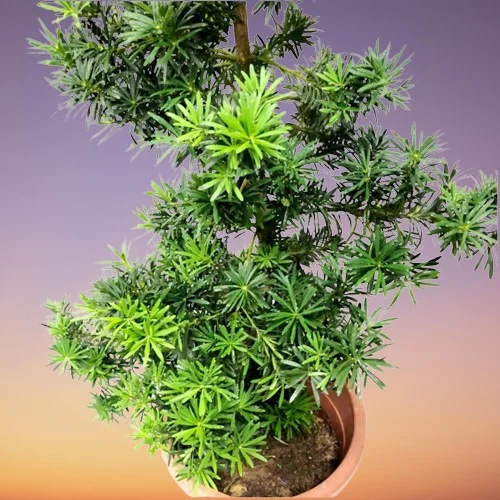
Podocarpus macrophyllus problems and remedies
Buddhist Pine common problems include elongated leaves, brown leaf tips, drooping leaves, pests and diseases among others. Keep reading for more on these problems, their remedies and solutions.
Pests
Common pests in Buddhist Pine are scale insects, spidermites, and mealybugs. Isolate the affected plant to prevent spread to the other plants and treat it with horticultural oil as recommended by the manufacturer.
Lower leaves long and elongated
Long and elongated lower leaves in Buddhist Pine are caused by too little light. This is an attempt by the plant to reach the light source. Move the plant to a brighter spot where it will receive bright light with 4-6 hours of direct sunshine or instal a grow light where natural light is insufficient. Check out this guide on understanding light for houseplants.
Brown leaf tips
One of the cause of brown leaf tips in Buddhist Pine is inconsistent watering. Maintain the soil moderately moist but not soggy during the growing season. Lessen watering in the cold period to keep the soil slightly moist but do not let the soil dry out completely. Learn more on how to water houseplants correctly.
The second cause of brown leaf tips is low humidity. To increase humidity, use a wet pebble tray or a humidifier. You may also grow the plant in a well-lit kitchen, bathroom, laundry area or other humid places in the home.
Drooping leaves
Drooping leaves in Podocarpus macrophyllus are due to two reasons. Number one reason is underwatering. Water thoroughly and the plant should perk up. Thereafter, keep the soil moderately moist during the growing season and slightly moist in the cold season. Never leave the soil to dry out completely for long periods.
The second reason for drooping leaves in Buddhist Pine is temperature stress either too high or too low temperature from drafts. Keep the plant away from drafts and maintain an average warmth of 15-240C. Take a look at this guide on understanding temperature for houseplants
Conclusion
Buddhist Pine (Podocarpus macrophyllus) is a low-maintenance, elegant evergreen plant that thrives indoors with the right care. With proper lighting, watering, and occasional pruning, this resilient plant will continue to grow beautifully, offering year-round greenery and a touch of serenity to your space.
Frequently Asked Questions
1. How much sunlight does Buddhist Pine need?
Buddhist Pine thrives in bright light with with 4-6 hours of direct sunshine but can tolerate partial shade.
2. How often should I water my Buddhist Pine?
Water your Buddhist Pine when the top 1–2 inches of soil feel dry. Be cautious of overwatering, as it can lead to root rot.
3. Can Buddhist Pine grow in low light?
Buddhist Pine can survive in low light but may become leggy and sparse. For optimal growth, provide medium to bright light.
4. Why are the leaves of my Buddhist Pine turning yellow?
Yellowing leaves in your Buddhist Pine are usually a sign of overwatering or poor drainage. Ensure the pot has drainage holes and let the soil dry between waterings.
5. Does Buddhist Pine require high humidity?
Buddhist Pine prefers moderate humidity but can tolerate dry indoor air. Using a pebble tray or a humidifier can help maintain air moisture levels.
6. How long does a Buddhist Pine live?
With proper care, Buddhist Pine can live for decades, making it a long-term indoor plant companion.
7. Does Buddhist Pine require frequent fertilization?
No, Buddhist Pine does not require frequent fertilization. Fertilize once every 4–6 weeks during the growing season and reduce feeding in winter.
8. Is Buddhist Pine suitable for bonsai?
Yes, Buddhist Pine is a popular choice for bonsai cultivation due to its dense foliage and slow growth rate.
You liked it? Share on social media.
Related Content
Amazon Associates Disclosure
Homeplantsguide.com is a participant in the Amazon Services LLC Associates Program, an affiliate advertising program designed to provide a means for sites to earn advertising fees by advertising and linking to amazon.com.
